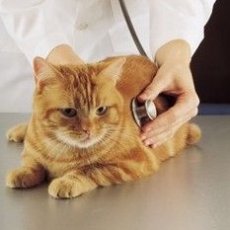New publications
How to give medicine to a cat
Last reviewed: 08.07.2025

All iLive content is medically reviewed or fact checked to ensure as much factual accuracy as possible.
We have strict sourcing guidelines and only link to reputable media sites, academic research institutions and, whenever possible, medically peer reviewed studies. Note that the numbers in parentheses ([1], [2], etc.) are clickable links to these studies.
If you feel that any of our content is inaccurate, out-of-date, or otherwise questionable, please select it and press Ctrl + Enter.

Do not give your cat any medications until you have spoken to your veterinarian to ensure that the medication is appropriate for your cat and is safe for the circumstances. You should also ask for recommendations on how to administer the medication and the correct dosage for your cat.
Tablets, capsules and powders
By far the best way to give your cat a pill is to use a commercial treat made specifically for this purpose. Although your cat can gently remove a pill from a bowl of canned food, these treats are sticky enough to make removing the pill nearly impossible. They are also soft, so they easily stick to the pill. Examples include Pill Pockets and Flavor Doh.
Administering pills this way avoids the daily struggle of trying to give your cat medication, which can be stressful for both of you. It also helps avoid the medical problems associated with forcing a pill down your cat's throat.
You can also try making small "meatballs" out of canned cat food or tasty meat pieces. Give your cats one or two meatballs without the pill, then one with the pill. Then give another meatball without the pill, so your cat will continue to take the treats even if she tastes the medicine.
Of course, these methods will only work if it is acceptable to give the cat the medicine with food. Always consult your veterinarian on this matter. If the pills cannot be given with food, you will need to tame the cat and give it the pill directly.
Unless your cat is used to taking pills, it may be helpful to wrap her body and paws in a towel.
Place your thumb and index finger on the sides of your cat's face, above and behind the whiskers. Gently press between the teeth. When your cat opens its mouth, press down on the lower jaw and place the pill as far as possible on the tongue. Close your cat's mouth and massage or rub its throat until it swallows. Many cats will also swallow if you gently blow into their nose or face. If your cat licks its nose, it has probably swallowed the pill. Always give your cat at least one teaspoon (5 ml) of water from a syringe or dropper after giving the pill. This helps the pill go down to the stomach where it can work, rather than sitting in the esophagus where it has no effect and may actually cause harm. Pills that get stuck in the esophagus can cause vomiting and even irritation of the tissue lining the esophagus. If the tablets are constantly stuck in the esophagus, the esophagus may become narrow or ulcers may develop. The same applies to capsules. Therefore, after tablets that are taken without food, it is always necessary to give the cat water.
Do not crush the tablets. Tablets crushed into powder may have an unpleasant taste, which cats do not like. Many tablets have a protective coating, which is important for delayed release in the intestines.
Liquids
Liquid medications, including electrolytes and aqueous solutions, are injected into the cheek pouch between the teeth and cheek. A medicine bottle, dropper, or plastic syringe without a needle may be used to inject the liquid.
Adult cats can be given up to 3 teaspoons (15 ml) of liquid medication at a time. Measure the required amount into a bottle, syringe, or dropper. (Use a plastic dropper if your cat bites it.) Restrain the cat as for administering tablets (described above). Insert the tip of the dispenser into the cheek pouch and, with the cat's chin up, slowly insert the medication. The cat will swallow it automatically.
Injections
The introduction of foreign substances into the body always carries the risk of acute allergic and anaphylactic reactions. Treatment of anaphylactic shock requires immediate intravenous administration of adrenaline (epinephrine) and oxygen. Therefore, it is best to have the injections performed by a veterinarian. As a precaution, it should be noted that the drug should not be administered by injection to a cat that has already had an allergic reaction to the drug.
If you need to give injections at home (for example, if your cat has diabetes), have your vet show you how. Some injections are given subcutaneously, others intramuscularly. The instructions on the package will tell you how to give the injection correctly.
 [ 1 ]
[ 1 ]
